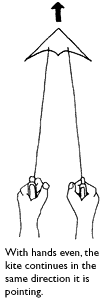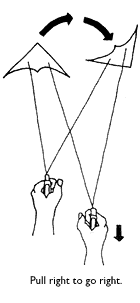|
Home Online Course Directory Previous Course - 202 Next Course - 204 |
Controlling Your Kite |
|
|||||||||||||
|
Forward and Reverse Flight Forward and reverse flight is somewhat discussed in the above section. Forward flight is the normal flight of your kite. For single line kites normal forward flight is automatic. For dual line kites, as long as you have enough wind and are not stalling the kite, the kite will travel in a forward motion, again very automatic. Quad line kites are a little different. To obtain normal forward flight, a quad line kite must have a positive angle of attack. This usually is achieved by keeping more tension on the upper lines and less tension if any on the lower lines. Power kites usually require very little tension on the rear lines during forward flight. Quad line stunt kites may require a little more than power kites but still have the majority of the pressure applied to the leading edge lines (upper lines). Forward flight is usually very simple to achieve, reverse flight can be a bit more difficult. For single line kites, reverse flight is nearly impossible. Stalling the kite by putting excessive slack in the line is pretty much the only way to get a single line kite to fly backwards. Dual line kites are similar, but reverse flight can be done. To get reverse flight from a dual line stunt kite you will first need to stall the kite and then move towards the kite fast enough that the kite does not power back up and regain forward motion. By moving towards the kite you will take the wind out of the kite and gravity will begin to take its toll and the kite will begin to float backwards in reverse flight. Careful controls on the flying lines will keep the kite in control and moving in the direction you wish to go. Reverse flight is where quad line kites really excel above other kites. With the ability to change the angle of attack from a positive angle to a negative angle, reverse flight is not only possible but can be done easily with total control of the kite. Reverse flight on a quad line stunt kite can be done with good speeds as well. The Revolution Supersonic can travel in reverse as fast as the EXP can travel forward. Quad line ram-air power kites can fly in reverse but are not really designed for reverse flight and as speed increases, the kite will fold up on itself and control will be minimal. The link mentioned above has some great diagrams on reverse flight as well as many other stunts. Basically, to obtain reverse flight with a quad line kite you only need to rotate both handles evenly so that the tops are towards the kite and the bottoms (brakes) are towards you. As you rotate the handles the kite will slow down, stall, and then begin to fly backwards. AS long as you hold the handles in this position the kite will continue to fly backwards, even if it is a foil kite and it has partially collapsed. You can even reverse-launch your kite off of the ground and fly the kite to zenith completely in reverse. Some practice may be needed to accomplish this but it can be done fairly simply. Remember that every kite will fly differently and some techniques listed above may not apply to your brand of kite, these are only the basics for the majority of kites on the market today. |
|||||||||||||
|
Flying your kite in and out of the wind window By mastering your control of your kite you will be able to fly your kite in and out of the wind window. For power kites this is a must, especially if you get caught in a gust or the wind increases. Being able to fly your kite to the edge of the window could save you from damaging your kite or even possible injury. Stunt kites can also benefit from this as well, especially ultra light or indoor kites that cannot handle large gusts of wind. Not only can you take your kite out of the power, with proper control you will be able to keep your kite IN the power longer, maximizing the power available on power kites and also being able to perform even more stunts with your stunt kite. Most people can fly the kite back and forth through the power fairly simply. The ones that excel above the others are the ones that can continuously fly the kite in the power without having to take the kite out of the power. With the ability to quickly turn your kite, you will be able to get more performance from your kite in both overpowered and underpowered situations. Being able to back your kite up is a lot faster than having to loop the kite back into the window and then loop it back out. Take the time to fully master the controls of your kite and you will be a better pilot in all areas. |
|||||||||||||
|
Online Course Directory Home |
|||||||||||||
Site Design by GamelordProductions.com





